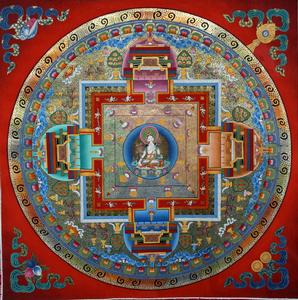Characteristics
Thang-ga is a unique form of painting art in Tibetan culture with distinctive national and religious characteristics as well as exceptional artistic style. Traditionally, dyes used are such valuable minerals and gemstones as gold, silver, pearl, agate etc. and plants like saffron, rhubarb etc. And because of these natural dyes, the painting will have gorgeous color and can be preserved for hundreds of years without any change in color. As a result, Thang-ga is known as the art treasure of Chinese ethnic painting, and Tibetan encyclopedia, also the precious intangible cultural heritage in Chinese folk art.
Color
Thang-ga painters classify dyes into nine categories: soil, stone, water, fire, wood, grass, flower, bone and gemstone. These natural dyes can also be categorized into seven colors as white, yellow, red, blue, green, black and purple.
All of the dye may also fall into mineral and plant category. Common mineral dyes are Renbu argil, cinnabar, lapis lazuli, malachite, and yellow lead etc. Plants include cyanidin, coccineus and so on, whose manufacturing is easier than that of minerals.
Cotent
Known as the encyclopedia of Tibetan culture, Thang-gas mainly concentrate on religion, but also touch history, politics, economy, culture, folklores, architecture, medicine, astronomy etc. Regarding the contents of Thang-gas, there are usually two kinds: religion and non-religion.
Religion-related Thang-gas include images of mandalas, Buddhist, Arhat, and portraits of wheel of life or Sukhavati etc. And non-religion Thang-gas involve contents of history, legends, astronomy, Tibetan medicine etc.
Genre
There are several genres of Thang-ga along its long development history. For example, the Nepal School started in 7th century, the Qiwu Gangba School in Zongkaba period, the ManThangPa and ChenZher School in 15th century, and Karzhi School etc.
Process
The rigorous and complicated procedure of drawing Thang-ga is supposed to follow the order of Guru, including a set of processes like initial rituals, canvas production, coloring, outlining, mounting and so on. And it usually takes a long period to finish a Thang-ga, ranging from half a year to more than a decade.

